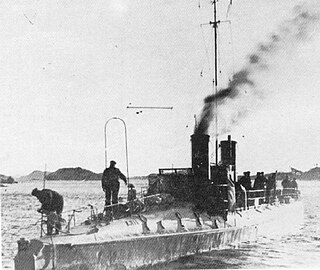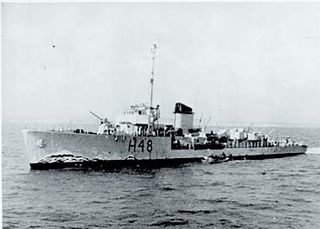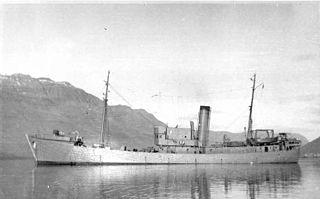
MS Rigel was a Norwegian vessel built in Copenhagen, Denmark, in 1924. The ship was used as a German prisoner of war (POW) transport during World War II, and was sunk by British Fleet Air Arm aircraft off Norway on 27 November 1944 with more than 2,500 dead, mostly POWs.

HNoMS Kjell was the final ship of twenty-seven 2nd class torpedo boats built for the Royal Norwegian Navy, launched at the Royal Norwegian Navy's shipyard in Horten on 12 March 1912 with build number 106. Kjell saw more than 32 years of service, the first 28 years in the Royal Norwegian Navy during the First World War and in the interwar period, the last four in the Kriegsmarine, having been captured in the first days of the 1940 Norwegian campaign. After being rebuilt as a minesweeper by the Germans, she was sunk by Royal Air Force de Havilland Mosquito fighter bombers on 28 September 1944. Divers rediscovered the shipwreck in 2006.

HNoMS Sleipner was a destroyer commissioned into the Royal Norwegian Navy in 1936. The lead ship of the Sleipner class, she gained near-legendary status in Norway by enduring over two weeks of intense air attack by Luftwaffe bombers following the 9 April 1940 invasion of Norway. After the resistance in South Norway started unravelling she made her way over the North Sea to continue the fight against the Germans from exile. After serving as a convoy escort along the coast of the United Kingdom, she was decommissioned in 1944. She was recommissioned in 1948 after being converted to a frigate. Along with her surviving sister ships she was sold for scrapping in 1959.

HNoMS Gyller was a Sleipner-class destroyer commissioned into the Royal Norwegian Navy in 1938. Along with the other Sleipner-class vessels in commission at that time, she took part in protecting Norwegian neutrality during the Second World War. After initially serving in the far north during the Finno-Soviet Winter War, she was redeployed to Southern Norway, escorting ships through Norwegian territorial waters. When the Germans invaded Norway on 9 April 1940, she was docked at Kristiansand. After taking part in the defence of the port city, she was captured intact by the invading Germans. Renamed Löwe, she sailed with Nazi Germany's Kriegsmarine for the duration of the war.

SS Glitra was a steam cargo ship that was launched in 1881 as Saxon Prince. In 1896 she was renamed Glitra. In 1914 she became the first British merchant vessel to be sunk by a u-boat in the First World War.

HNoMS Honningsvåg was a naval trawler that served throughout the Second World War as a patrol boat in the Royal Norwegian Navy. She was launched at the North Sea harbour of Wesermünde in Hanover, Germany in February 1940 as the fishing trawler Malangen and was captured by Norwegian militiamen at the North Norwegian port of Honningsvåg during her maiden fishing journey to the Barents Sea. Having taken part in the defence of Norway in 1940 she spent the rest of the war years patrolling the ocean off Iceland. She was decommissioned in 1946, sold to a civilian fishing company in 1947 and scrapped in 1973.

SS Henry was a Norwegian steam-powered cargo ship best known for being one of the two ships sunk in one of the most controversial incidents in Norway during the Second World War.

SS Irma was a 1,322-ton steamship built by the British shipyard Sir Raylton Dixon & Co. Ltd. in Middlesbrough in the north-east of England. She was delivered to the Norwegian passenger ship company Det Bergenske Dampskibsselskab of Bergen in 1905. Irma sailed for the company until she was attacked and sunk by two MTBs belonging to the Royal Norwegian Navy on 13 February 1944.

SS Dronning Maud was a 1,489 ton steel-hulled steamship built in 1925 by the Norwegian shipyard Fredrikstad Mekaniske Verksted in Fredrikstad. Dronning Maud was ordered by the Trondheim-based company Det Nordenfjeldske Dampskipsselskap for the passenger and freight service Hurtigruten along the coast of Norway. She served this route as the company flagship until she was sunk under controversial circumstances during the 1940 Norwegian Campaign.

SS Barøy was a 424-ton steel-hulled steamship delivered from the Trondhjems mekaniske Værksted shipyard in Trondheim in 1929. She had been ordered by the Norwegian shipping company Ofotens Dampskibsselskab for the local route from the port city of Narvik to the smaller towns of Lødingen and Svolvær. After the company suffered ship losses in the 1940 Norwegian Campaign Barøy was put into Hurtigruten service on the Trondheim–Narvik route. She was sunk with heavy loss of life in a British air attack in the early hours of 13 September 1941.

HMT Empire Windrush, originally MV Monte Rosa, was a passenger liner and cruise ship launched in Germany in 1930. She was owned and operated by the German shipping line Hamburg Süd in the 1930s under the name Monte Rosa. During World War II she was operated by the German navy as a troopship. At the end of the war, she was taken by the British Government as a prize of war and renamed the Empire Windrush. In British service, she continued to be used as a troopship until March 1954, when the vessel caught fire and sank in the Mediterranean Sea with the loss of four crew. HMT stands for "His Majesty's Transport" and MV for "Motor Vessel".
HNoMS Tor was a Sleipner-class destroyer of the Royal Norwegian Navy that was launched in September 1939. She was under outfitting and testing when Nazi Germany invaded Norway on 9 April 1940. Although scuttled by Norwegian naval personnel to prevent her from being captured by the invading forces, she was soon salvaged by the Germans and put into service with the Kriegsmarine. Under the name Tiger she served out the war as an escort and training vessel, being recovered by the Norwegians in Denmark after the German capitulation in 1945. After the war she was converted to a frigate and served until 1959.
MS Ravnaas was a Norwegian cargo ship built in 1931, and sunk by Japanese aircraft in the Pacific Ocean in December 1941.
MT Vardaas was a Norwegian oil tanker, built in 1931. She could carry 12,683 DWT. Sailing for Arnt J. Mørland's shipping company and Nortraship, while on its way from Cape Town to Trinidad carrying dead freight, the ship was hit by a torpedo from the German submarine U-564 on 30 August 1942. All crew of 41 escaped in lifeboats and landed in Plymouth Bay, Tobago.

The Kvarstad vessels were a number of Norwegian ships held in arrest in Gothenburg during World War II. The ships had been visiting Swedish ports when the German invasion of Norway took place in April 1940. They were eventually claimed by Nortraship, which represented the Norwegian exile government and the British Government, but also by the Germany-supported Quisling regime in Norway. The fate of the ships was disputed through a number of diplomatic notes and trials between the involved parties. The disputed vessels originally numbered 42 ships, with a total of 170,000 ton dw. Some of the ships returned early to occupied Norway, some after recommendation from the Administrative Council. In January 1941 the British Operation Rubble succeeded in bringing five of the ships to the Orkney Islands.

MV B. P. Newton was a Norwegian tanker built in 1940, and sunk by German submarine off South America in July 1943.

Operations: Norwegian campaign HNoMS Storm was a 1. class torpedo boat constructed in 1898. Storm served the Royal Norwegian Navy for almost 42 years, including neutrality protection duties during the First World War. She was lost in the 1940 Norwegian campaign of the Second World War. During the Norwegian Campaign, she was the only Norwegian warship that launched a torpedo against the invading Germans.
MTB 345 was an experimental motor torpedo boat constructed in 1941, which saw limited service with the Royal Navy before being transferred to the exiled Royal Norwegian Navy on 16 March 1943. She sailed with the Royal Norwegian Navy for three months in 1943, until captured by German forces on 28 July 1943, during her second mission to the coast of occupied Norway. Two days after their capture, the crew of MTB 345 were executed by the Germans based on Hitler's Commando Order. Following their capture of MTB 345, the Germans pressed the motor torpedo boat into Kriegsmarine service, renaming her SA 12. The fate of SA 12 since December 1943 is unknown.

SS Kommandøren was a steel-hulled passenger/cargo steamship built in Norway in 1891. She served as a communications link between the regional capital of Western Norway, Bergen, and the various communities of Sogn og Fjordane county.
Niels Larsen Bruun was a Norwegian officer who served in the Royal Norwegian Navy for more than four decades. Bruun took part in neutrality protection duties during the First World War, seeing service on several naval vessels and assuming his first command. He continued his service in the inter-war years, teaching at naval schools in addition to shipboard service.














